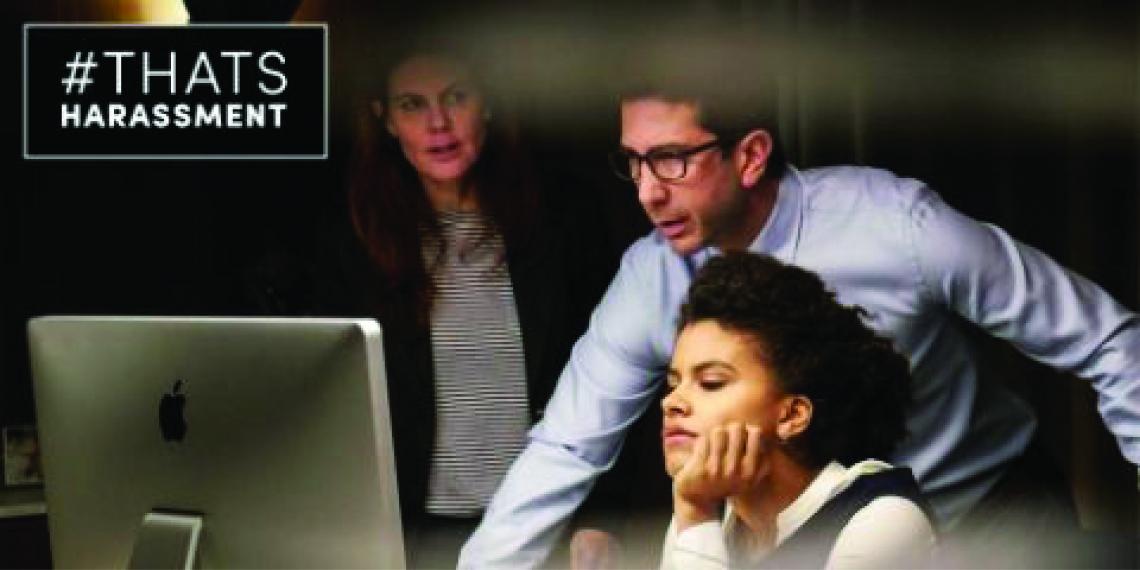That's Harassment

A new short film series entitled #thatsharassment seeks to depict sexual harassment in everyday settings, so women can be equipped to respond.
That's Harassment is a project by American-Israeli writer and director Sigal Avin - who wanted to give context to the ugly 'everyday face' reality of sexual harassment, in the hopes that women will be better prepared to respond.
"I realized that I really wanted to see what sexual harassment was instead of hearing about it and reading about it all the time,” says Avin. “There was nothing on it, everything was much more violent, or unreal, but there was nothing that showed the gray area of sexual harassment."
Using five short films (see the bottom of page), she documents scenarios of women experiencing unwanted sexual advances in normal work or life situations. Below are the ways that we can respond.
Raising the profile
A survey of women in the workplace revealed that 1 in 3 women have experienced sexual harassment. 44% said they had experienced unwanted touching and advances. The survey found that while some women reported having experienced unwelcome sexual approaches or degrading comments, they hadn't realised those actions constituted sexual harassment and were unlawful.
Whlie the #thatsharassment videos may prove difficult to watch, they are crucial in portraying different ways women's lives are beset with sexual harassment in the public sphere.
'The Boss', 'The Doctor', 'The Politician', 'The Photographer' and 'The Co-worker' (see the bottom of page) are each shot to reveal how the unfair dynamics of power, element of surprise, unwitting intimidation and social conditioning leave the subjects feeling powerless to respond to the unwanted and inappropriate sexual advances.
In revealing these normal situations that subtly escalate into sexual harassment (and labelling it such), women may be able to more clearly quantify behaviour in the future that makes them feel unsafe. This provides the opportunity to respond.
Raising the alarm
The New Zealand State Services Commission conducted a survey in 2013 which found only 1% of their employees reported sexual harassment. Based on volumes of other data around sexual harassment in the workplace, there appears to be a large discrepancy between what women are experiencing and what is being reported.
In an article entitled 'Why we fail to report sexual harassment', the three female authors interviewed 31 women in male-dominated industries. They found that 75% of the women had experienced sexual harassment in those fields, regardless of education or status. Significantly less had officially reported the harassment. They found that three things contributed to the under-reporting:
- fear of retaliation - a concern that reporting harassment will lead to repercussions for the victim.
- the 'bystander effect' - feeling uncertain or unprepared to respond when witnessing unwanted behaviour.
- 'masculine' culture - a toxic warping of culture where women especially are openly objectified.
While these fears are valid, there are many programs, resources and policies available for your protection and action should you experience or witness sexual harassment.
Learn about your rights: Many organisations have their own specific policies and practices in reporting and addressing sexual harassment - which they are legally bound to. Find out through your Human Resources manager or business website what your company's policies are. The Human Rights Commission has this outline to help you know your legal rights in preventing discrimination and harassment.
Know the signs: The United Nations has prepared this great resource to help identify what sexual harassment looks like: What is Sexual Harassment PDF [4 pages, 14KB].
Speak up for others: The State Services Commission and the Ministry for Women have developed a policy guideline on prevention and response to workplace sexual harassment. You can make a difference for others with your voice. They also have this fantastic resource to download that specifically address the bystander effect and creating healthy workplace cultures: Calling Out Sexual Harassment in the Workplace PDF [16 pages, 5MB].
The Salvation Army has these policies in place for sexual misconduct and you can complete a complaint form should you experience harassment within our organisation.
Raising the standard
'Discrimination may also be unintentional. The person who is being offensive may be unaware of its effect, but they can still be held responsible. What is important is how the behaviour affects you or others.' - Human Rights Commission
While sexual harassment may be written off by the perpetrator or even the victim - we must each be advocates if we want to create safe, healthy environments for people to flourish in.
The Salvation Army is committed to this.
Our mission plan for 2017 is based on the premise that we are 'Te Ope Whakaora - the Army that brings Life.'.
We see this happening by 'Living like Jesus' and 'Doing Mission Together'.
This means that we raise the standard and treat others the way Jesus treated them - with dignity, compassion and respect as we work alongside our brothers and sisters.
If you experience, witness or feel you yourself are perpetuating sexual harassment - please check out the resources and links listed in this article or talk to your line manager. There is help available, and harassment is not okay.
We hope that the videos below and the #thatsharassment campaign will provide a platform for both women and men experiencing or furthering harassment in the workplace to respond proactively and create a better way forwards.
